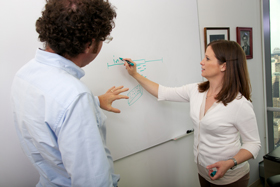
Call Jérémie Palacci’s laboratory at the University of California San Diego (UCSD) many things: new, modern, high-tech. But don’t call it white.
Jérémie Palacci, who was a Blavatnik Regional Award finalist in 2014, joined the UCSD faculty as assistant professor of physics earlier this year, after completing a postdoc at New York University (NYU). Now, another choice loomed: what color did he want the university to paint the walls of his newly renovated lab? What sounds like a joke was actually the first lesson on the learning curve of what is arguably the biggest transition in academic life—the move from postdoc to faculty.
 “The architect and I settled on some bright colors for the lab, and before we got any further, the university stepped in,” he recalls, laughing. “I think they should have asked me ‘which shade of white would you like?’ I had to negotiate to get what I wanted, but we pulled it off.” Palacci says that the bold choices he made for the lab are in line with the dilemma he faced when deciding where to start his life as a faculty researcher.
“The architect and I settled on some bright colors for the lab, and before we got any further, the university stepped in,” he recalls, laughing. “I think they should have asked me ‘which shade of white would you like?’ I had to negotiate to get what I wanted, but we pulled it off.” Palacci says that the bold choices he made for the lab are in line with the dilemma he faced when deciding where to start his life as a faculty researcher.
“Everyone who worked with me joked that they couldn’t envision me in California — I don’t look like a surfer, but when the opportunity with UCSD came along, I asked myself: Can you change? Can you adapt?” He headed west, realizing quickly that having his own office meant more than just the luxury of privacy. “At NYU, I was part of a center with six people, working in an open space with forty students and postdocs. Here, you arrive, get an office, and the rest is up to you. There’s no babysitting.”
Emily Hodges, a 2013 Blavatnik Regional Award finalist who is now assistant professor of biochemistry at Vanderbilt University School of Medicine, echoed Palacci’s comments. Hodges finished her postdoc at Cold Spring Harbor Laboratory in New York and moved to Nashville in January, knowing that both the geographical and cultural shifts would be significant.
“The safety net is gone. On a day-to-day level as a postdoc, you are always consulting with people…you have constant feedback, constant discussion. Without that, you have to trust yourself,” - says Emily Hodges, 2013 Blavatnik Regional Award Finalist.
The Other Side of the Podium
Balancing the many roles expected of a professor—teacher, mentor, researcher and grant-writer, to name just a few—revealed an element of the postdoc-to-faculty transition that Palacci believes is underexposed. “If you work in industry, you learn to multitask. But when you’re a researcher or a postdoc, your schedule is pretty much one-track,” he says.
Making the faculty shift has necessitated a crash course in time management, but Palacci is a quick study, refusing to let the juggling act get in the way of one of the most rewarding aspects of his new job: teaching. “For me, teaching is a breath of fresh air,” Palacci says. “Sometimes you do research and it’s not working and you get very frustrated, he explained. “Teaching gives me a chance to do something else.”
 Hodges, who is a regular guest lecturer but does not maintain a full teaching schedule, says her interactions with students are also a vital source of easy social interaction, something she misses from her days as a student. “Now that I’m on the other side, I’m in a different social dimension,” she says, noting that collaborations easily forged among students take more effort at the faculty level. “You have to be really proactive in identifying people you want to work with.”
Hodges, who is a regular guest lecturer but does not maintain a full teaching schedule, says her interactions with students are also a vital source of easy social interaction, something she misses from her days as a student. “Now that I’m on the other side, I’m in a different social dimension,” she says, noting that collaborations easily forged among students take more effort at the faculty level. “You have to be really proactive in identifying people you want to work with.”
Making Bets
Hodges and Palacci noted that at their new university homes, they are solo acts, pursuing areas of inquiry that are unique within their departments. Both see this an opportunity, especially as they form their own labs.
Palacci says it’s a chance to put his own stamp on a field where, up until now, he has trained under the tutelage of others. “I want my lab to be an experience, not a vertically structured thing,” he said, explaining that his students will have flexibility in their roles and activities. Calling to mind the kind of energy and creativity more often found in startup companies than in university labs, Palacci is eager to “put some imagination back into the scientific process.”
For Emily Hodges, the first year “has flown by,” and as her lab takes shape, she hopes to impart the same passion and enthusiasm to her graduate students that her mentors, “my greatest inspirations,” did during her training.
Jérémie Palacci reflects on his transition much the way an entrepreneur looks back on the beginning of a new venture. “When you move from postdoc to faculty, people are going to bet on you. The university gives you space and funding, just like investors in a company. In the beginning, you play architect, making decisions and placing your own bets. It’s going to work or it’s not—either way it’s such a great challenge.”